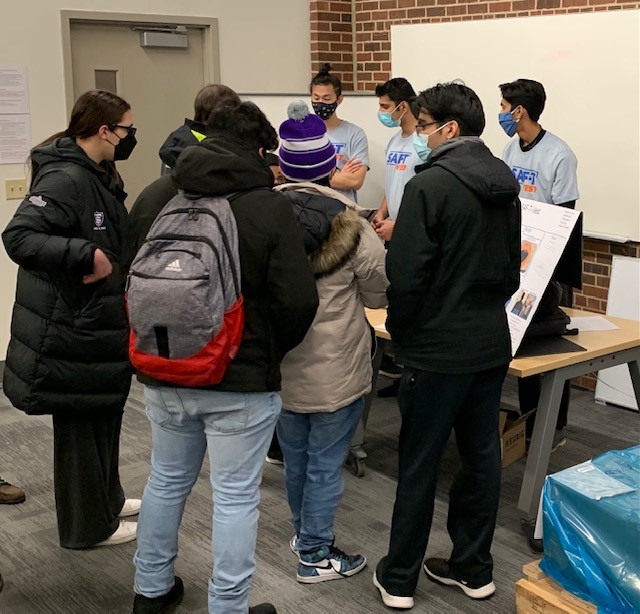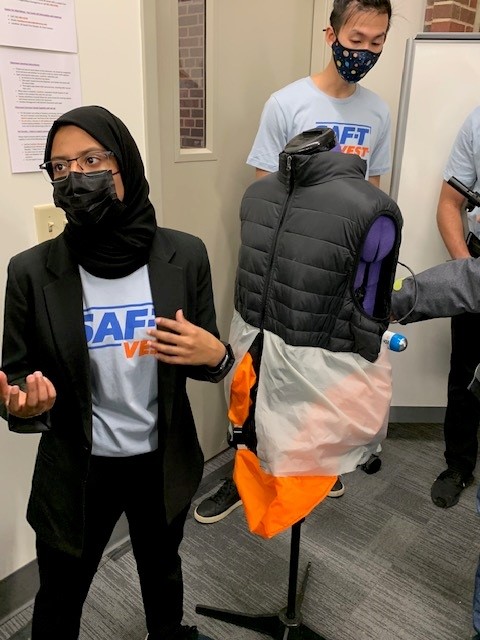Two-year collaboration with UST’s School of Engineering culminates with proof of concept and evidence of feasibility
ST. PAUL (December 9, 2021)—Davenport SAF-T Systems revealed its patented SAF-T VEST™ proof of concept and first-generation prototype at the Senior Design Show at the University of St. Thomas School of Engineering. It’s a major milestone in the company’s mission to reduce devastating injuries from falls.
designed to reduce the risk of devasting injuries in falls among older adults.
“This is an incredibly important day because, for a lot of people, seeing is believing,” said Ryan Davenport, (UST ’89) CEO and co-founder of Davenport SAF-T Systems. “We’ve known for a long time this idea would work but we also understand that saying it and showing it are two different things.”
Thanks to a strong collaboration with the University of St. Thomas School of Engineering, the company tapped the skills of two groups of senior engineering students. The 2020 SAF-T VEST team began its work by meeting over Zoom with the inventor, Jay A. Davenport, M.D., a retired orthopaedic surgeon. They learned why the vest was needed, how it was designed to protect fracture-prone areas of the body and all the different ways people can fall.
Students say they were motivated to succeed because of the importance of the project.
“It is exciting to work on a real engineering project for the purpose of helping others,” said Rahaf Bahajry, a mechanical engineering student and a member of this year’s SAF-T VEST team.

As seen in the above video, the prototype deploys only one airbag, which is designed to offer protection in a forward fall. The more advanced wearable technology envisioned by the founders will feature a network of airbags providing fall injury protection from the hips to the head, no matter which direction the user falls.
Still, this prototype demonstrates all the core functions of the future version. For example, it:
- Recognizes, with onboard motion sensors, when an imminent fall is about to happen.
- Inflates a customized airbag in less than a third of a second; then,
- Deflates rapidly so the airbag absorbs the impact of the fall.
“The student engineers have done sensational work,” said Dr. Davenport. “They’ve demonstrated that fall injury protection is feasible and therefore necessary. They’ve also shown how the SAF-T VEST can help older adults in a forward fall avoid serious injury and remain active and independent.”
The Senior Design Clinic affords students the opportunity to gain experience working with outside industry, while the company receives high-level engineering services and peek at up-and-coming talent in the pipeline.

Next steps
The company is seeking up to $350,000 in seed funding through venture capital or angel investors. It is also applying for development grants from allied industries and government research agencies. The money will be used to build on the work of the St. Thomas engineers to create an advanced prototype suitable for human studies and rigorous testing. The company is also collaborating with a noted expert in fall detection from the University of Illinois at Chicago.
About the company
Davenport SAF-T Systems is developing the SAF-T VEST (U.S. Patent No.10,897,938), a wearable “smart” vest designed to reduce the risk of injury in falls. Injuries suffered from falls are a public health crisis. In 2015, the direct medical cost of fall injuries in the U.S. topped $50 billion.
The SAF-T VEST was invented by Company founder Jay A. Davenport, M.D., a board-certified orthopaedic surgeon. It’s equipped with sensors that continuously monitor the user’s center of balance. When an unrecoverable fall is detected, a microprocessor triggers a network of airbags to inflate in a fraction of a second, absorbing the impact of the fall and deflating rapidly for a soft landing. The airbags protect the pelvis, hips, upper extremities and head.
